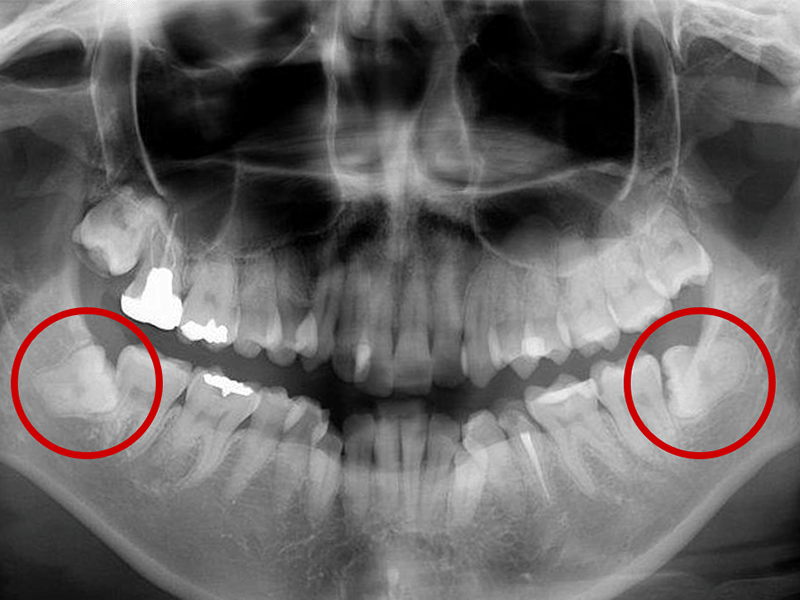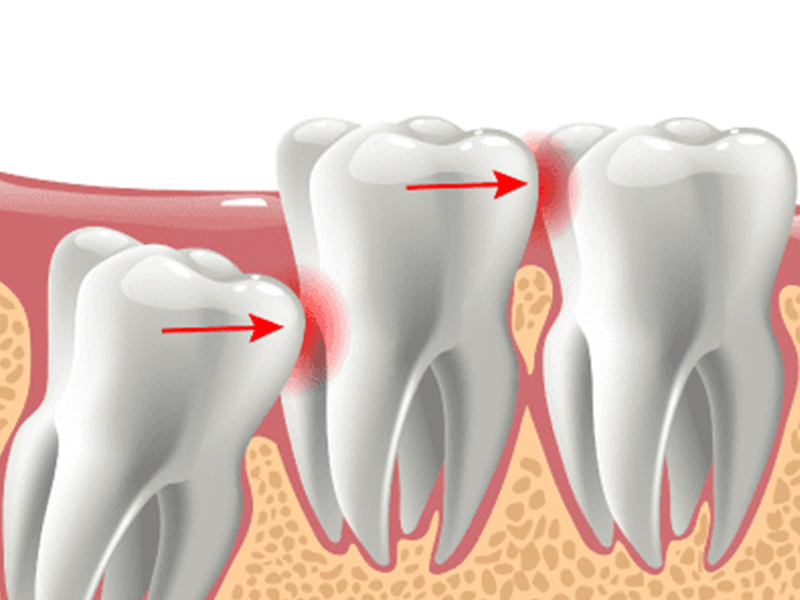About Oral Surgery Procedures
Please feel free to consult us if you notice any problems in your mouth.
Our oral surgery services cover the diagnosis and treatment of issues involving the teeth, tongue, jaw, and other areas of the mouth that may require surgical care.
Common procedures include the extraction of impacted wisdom teeth, treatment of oral injuries, and the diagnosis and management of temporomandibular joint (TMJ) disorders.

Wisdom Tooth Extraction
About Wisdom Teeth
Wisdom teeth are the third molars, located at the very back of the adult molars.
They typically emerge around the age of 20. Most people have four—two in the upper jaw and two in the lower jaw—but the number can vary. Some individuals may have fewer than four, or none at all.

Causes of Wisdom Tooth Pain
Wisdom teeth may grow in at an angle—sideways or slanted—or may be partially covered by the gums.
This creates areas where bacteria can easily accumulate, leading to various issues such as inflammation or infection, which can cause pain.
If a wisdom tooth is negatively affecting the surrounding teeth or gums, early extraction is recommended.
- If a wisdom tooth develops a cavity, it can also cause decay in the adjacent tooth.
- Wisdom teeth are prone to poor hygiene, leading to gum inflammation around them (pericoronitis).
- Erupting wisdom teeth may injure the cheeks or gum tissue, causing mouth ulcers.
- Wisdom teeth can affect the bite alignment and, in some cases, lead to temporomandibular joint (TMJ) disorders.
- Pressure from wisdom teeth may shift other teeth, causing changes in dental alignment.
Criteria for Wisdom Tooth Extraction vs. Preservation
Wisdom teeth do not always need to be removed.
Even if a wisdom tooth is present, it cannot truly fulfill its role as a functional tooth unless it properly aligns and bites with the opposing tooth. On X-rays, it is rare to find wisdom teeth that are perfectly upright—many are tilted or lying sideways. In such cases, food debris and plaque tend to accumulate, leading to inflammation of the surrounding gum tissue. This can cause swelling, pus, and significant pain.
In the long term, if the disadvantages outweigh the benefits, extraction is often recommended.
At Sakura Clinic, we assess whether a wisdom tooth should be extracted or preserved and monitored based on the following criteria:
Please note that these are general guidelines; the final decision is made after considering the patient’s individual condition holistically.

Cases Where Extraction is Recommended
- The wisdom tooth is growing at an angle and causing pain.
- Occasional pain around the wisdom tooth that subsides after a few days.
- The wisdom tooth has developed a cavity (dental caries).
- The cavity has reached the nerve, and root canal treatment is not feasible.
- The tooth next to the wisdom tooth has developed a cavity.
- The gums around the wisdom tooth are swollen (or have been swollen before).
- There is pain in the gums surrounding the wisdom tooth (or there has been pain previously).
- The wisdom tooth is irritating or injuring the gums or inner cheek.
- A dark shadow (indicative of a dentigerous cyst) is visible around the wisdom tooth on X-ray imaging.)
Wisdom Teeth Recommended for Extraction
We often hear patients say, “The area around my wisdom tooth swells occasionally, but it goes away in a few days, so I just left it.”
While the swelling may subside temporarily, the wisdom tooth may still be affecting the adjacent tooth.
If you experience any discomfort, please don't hesitate to consult us early.
Additionally, swelling and pain may occur after the extraction.
If you have an important event such as a meeting, presentation, trip, or other commitments coming up, we recommend avoiding extraction during that time.
Please plan your wisdom tooth removal with enough flexibility in your schedule.
Cases where wisdom teeth can be preserved
- The tooth is erupting (or expected to erupt) straight and has a proper bite alignment with the opposing tooth.
- The tooth has erupted straight and can be brushed without difficulty.
- The tooth is partially erupted but does not negatively affect adjacent teeth.
- The tooth is completely impacted in the bone and poses a low risk of future complications.
- There is no discomfort such as pain or swelling, and it does not interfere with daily life.
- The patient is able to maintain proper oral hygiene around the tooth.
Potential Uses for Preserved Wisdom Teeth
- Can be used for orthodontic or transplant purposes
- May serve as an abutment for future bridges or dentures
- Can be utilized to replace or support adjacent missing teeth
Cases Where Wisdom Tooth Extraction May Be Avoided
- If there is severe pain or swelling caused by a wisdom tooth, we first prescribe antibiotics to reduce the symptoms before performing the extraction.
- Since anesthesia, antibiotics, and painkillers are used during the procedure, extraction is generally avoided during pregnancy or breastfeeding whenever possible.
Risks After Wisdom Tooth Extraction
Although the extraction itself is not painful due to the use of local anesthesia, you may experience some discomfort or swelling afterward, depending on the individual.
The following symptoms may occur, but if you follow the post-operative instructions carefully and take appropriate care, recovery should proceed smoothly.
Swelling
Swelling typically peaks around 2 to 3 days after the extraction and then gradually subsides.
The degree of swelling varies from person to person. In general, more extensive bone removal or a larger area of gum incision tends to result in greater swelling.
Numbness After Extraction
After the removal of a lower wisdom tooth, some patients may experience numbness or tingling.
This is because a large nerve runs close to the roots of the lower wisdom teeth.
If the roots are in close contact with the nerve, even slight contact during extraction may cause temporary numbness or tingling.
In most cases, this gradually improves within about six months.
If you experience any unusual sensations, vitamin supplements that support nerve function may be prescribed to help alleviate symptoms.
Dry Socket
A dry socket occurs when a blood clot does not form properly or becomes dislodged after a tooth extraction, leaving the underlying bone exposed.
This condition causes constant pain, often described as a throbbing ache that follows the rhythm of your heartbeat. The pain can be quite severe.
In most cases, the condition improves with appropriate disinfection and anti-inflammatory treatment of the socket. However, if the symptoms persist, additional surgical treatment of the gum may be necessary.
Post-Extraction Care Instructions
Whether it’s a wisdom tooth or another tooth, please keep the following points in mind after an extraction:
If pain or bleeding does not subside, please contact us by phone.
Bleeding Control
If an incision was made in the gum, it is normal for saliva to be slightly blood-tinged until the following day. This is usually not a cause for concern.
However, if you experience prolonged or excessive bleeding, please contact us immediately.
Rest on the Day of Extraction
On the day of your tooth extraction, please avoid activities that can increase blood flow, such as prolonged bathing, alcohol consumption, and strenuous exercise.
An increase in blood circulation or body temperature may cause the wound to start bleeding again.
Do Not Touch the Extraction Site
Even if the extraction site feels strange, avoid touching it with your fingers or tongue.
Disturbing the area may dislodge the blood clot and lead to a condition called dry socket.
Take All Prescribed Medication
After a tooth extraction, antibiotics are often prescribed.
Be sure to complete the full course of medication as directed.
Pain may occur once the anesthesia wears off, so take pain relievers as needed.
In all cases, follow your dentist’s instructions carefully.
Diet After Extraction
To avoid swelling, re-bleeding, or delayed healing, please refrain from eating, drinking, or smoking immediately after the extraction.
Avoid eating until the anesthesia has completely worn off.
Refrain from hard, hot, or spicy foods that may irritate the wound.
Since reduced immunity can increase pain and swelling, try to maintain a balanced diet and ensure proper nutrition for a smooth recovery.

Oral Hygiene After Extraction
On the day of the extraction, avoid excessive or forceful rinsing.
Some bleeding may occur after the procedure, but the formation of a blood clot (called a "blood plug") at the extraction site is important for healing and tissue regeneration.
Frequent rinsing due to concern about bleeding can dislodge the clot, increasing the risk of developing a dry socket.
Brush your teeth carefully, avoiding the extraction area.
If you feel discomfort in your mouth after meals, gently hold water in your mouth and spit it out without swishing.
※調べたところ、海外では「うがい」をする習慣があまりないようですが、この箇所の注意書きは必要ですか?

If Swelling Occurs
Swelling after tooth extraction is common.
Avoid applying anything too cold directly to the area.
Instead, gently cool the area with a damp towel or cold compress.

Click Here to Book an Appointment
If you have any concerns about your health or oral condition,
please feel free to consult Sakura Clinic, a Japanese medical and dental clinic in Dubai.
